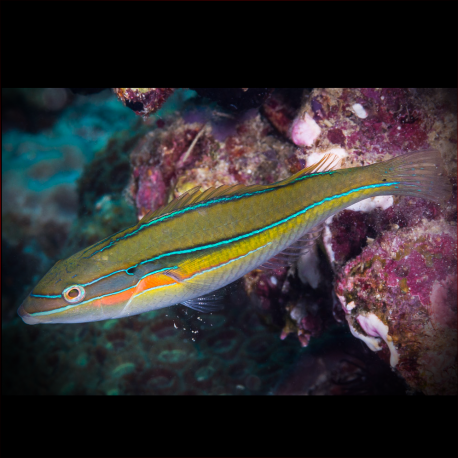More info
Datasheet
| Minimum Tank Size | 1000 litres / 264.17 US gallons |
| Maximum Size | 15.0cm / 5.91inches |
| Reef Compatible | Always reef safe |
| Temperament | Mostly peaceful but might be aggressive towards similar species |
| Temperature | 22.2°C / 71.96°F - 25.6°C / 78.08°F |
| Specific Gravity | 1.020-1.025 |
| Carbonate Hardness | 8-12 |
| pH | 8.1-8.4 |
General Description
The Three-ribbon wrasse, scientifically known as Stethojulis strigiventer, belongs to the Labridae family and is commonly referred to by various names such as Silver-streaked rainbowfish or Three-ribbon wrasse. These fish are renowned for their stunning appearance, especially when displaying vibrant colors. Juveniles may have a more matte coloring compared to adults.
Aquarium Suitability
Aquarists considering the Three-ribbon wrasse for their tanks should be aware of the species' demanding nature. These fish require constant feeding due to their high activity levels. They are known to jump out of open aquariums, so a secure lid is essential to prevent escapes. Additionally, the need for a varied diet to thrive makes them suitable for experienced aquarists willing to provide extra care.
Demands, Care, and Hardiness
With an average hardiness level, these wrasses thrive best in a well-established aquarium with ample space for swimming. They are relatively peaceful but can exhibit aggressiveness towards similar species. Three-ribbon wrasses are known to be sensitive during transportation and acclimatization, requiring a careful and gradual introduction to their new environment.
Reef Suitability
Reef aquarists will appreciate that the Three-ribbon wrasse is reef-safe, making them a valuable addition to a reef tank setup. They can help combat unwanted invertebrates like flatworms and pyramid snails, contributing to the overall health of the reef ecosystem.
Aquarium Setup
To cater to the needs of the Three-ribbon wrasse, aquarists should provide a spacious aquarium with a minimum tank size of 1000 liters. A deep sandy substrate is essential, as these fish often bury themselves when feeling threatened or in need of rest. The tank should offer hiding places among live rocks to allow the wrasses to retreat when necessary.
Behaviour
Known for their shy and docile nature, Three-ribbon wrasses prefer peaceful tank mates and can coexist well as a pair if introduced simultaneously. Their behavior includes digging themselves into the sand for protection or rest, showcasing an interesting adaptation to their environment.
Feeding and Diet
A varied diet is crucial for the Three-ribbon wrasse, consisting of small crustaceans like krill, mysis, and artemia, as well as zooplankton such as cyclops and pods. They are voracious eaters and must be provided with regular feeding to support their constant activity levels.
Dimorphism and Captive Reproduction
The Three-ribbon wrasse is hermaphroditic, with the ability to change gender from female to male as needed. In a captive setting, successful reproduction can occur if the fish are provided with suitable conditions, including a well-established aquarium with sufficient micro-life like copepods and amphipods.
Habitat and Distribution
Native to the Indo-Pacific region, from the Red Sea and East Africa down to South Africa and east to the Marshall and Tuamoto islands, the Three-ribbon wrasse thrives in tropical marine environments. They can be found in areas spanning from Sagami Bay, Honshu, to New South Wales, Australia, showcasing their wide distribution across the region.

